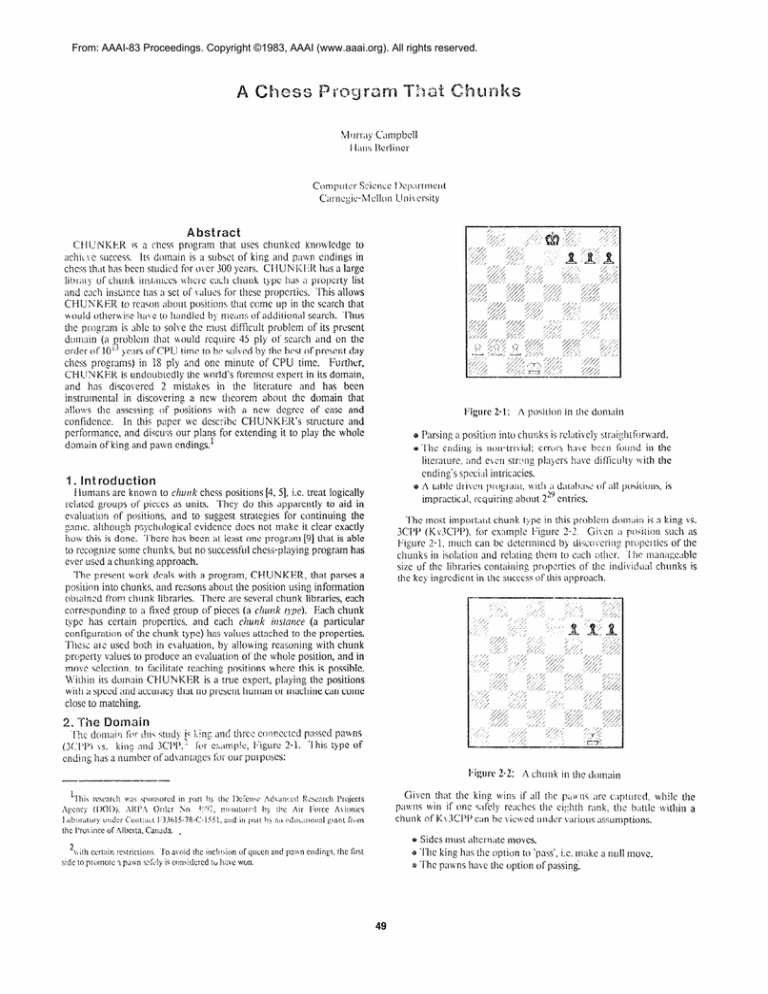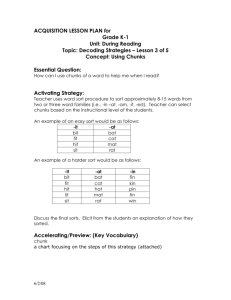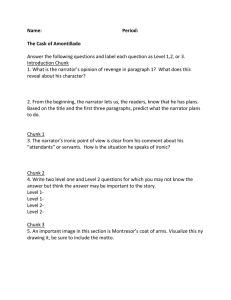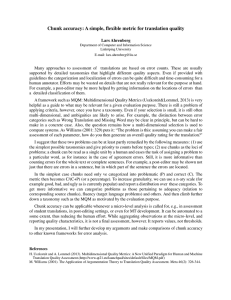
From: AAAI-83 Proceedings. Copyright ©1983, AAAI (www.aaai.org). All rights reserved.
Abstract
CJIL’NKER
I$ a chcn program that uscq chunked knoulcdgc
to
~&IL\ c success. Its domain is a subset of kii;g and pawn endings in
chess th,lt has been studied for 01 er 300 years. CI JUN i<I:R has a large
library of chunk inst;lnies where cnch chunk type has a property list
and each in&jl:ce has a set of \ cllues for these propcrtics.
‘I-his allows
CJ-IIJNI<EJ< to rcawn about positiow, that ccmc up in the starch that
\~ould othcrn ise h;l\ e to handled by me,ins of additional search. Thus
the program is able to sohe the most difficult
problem of its present
don~am (a problem that Mould require 45 ply of search and on the
order of 1Oi3 lears of CPU tlmc to be solved by the bcsr of prcscnt day
chess programs) in 18 ply c(nd one minute of CPU time.
Further,
CHI_!NKtiK
is undoubtedly
the world’s foremost expert in its domain,
and has diTcovercd
2 mist‘tkes
in the litcraturc
and has been
instrumental
in discovering
a new theorem about the domain that
with a new dcgrcc of cast and
al!o~s the asscssin g of posi:ions
confidence.
In this pdpcr- we describe CHUNKER’s
structure and
performance,
and diqcul;s our plans for extending it to play the whole
domain of king and pawn cndings.l
ITigore 2-1:
ODParsing a position
o ‘I he ending
litcrarure.
A position
in the domain
into chunks is rclari\cly
is non-tn\ial;
errors hat
and c~cn str:Jng plajcrs
straightfi)rward.
been folrnd
ha\,c difficulty
in the
M ith the
ending’s spcci.il intricacies.
1. Int rsductisn
I lumans arc known to CAU& chess positions [4, 51, i.e. treat logically
rclatcd groups of picccs as units. ‘I‘hcy do this apparently to aid in
evaluation
of positions. and to suggest strategies for continuing
the
gan~c. although psychological
evidence does not make it clear exactly
ho\+ this is dcnc. l‘hcrc has been at least one program [9] that is able
to rccognile some chunks, but no successful chess-playing program has
ever used a chunking approach.
‘J’hc preycnt work deals with a program, CHUNKER,
that parses a
posiGon into chunks, and reasons about the position using information
obrainzd from chlmk libraries. Thcrc are several chunk libraries, each
corresponding
to a fixed group of picccs (a chujlk !~yf). Each chunk
type has certain propcrtics,
and each chunk ir~nrlce (a particular
configuration
of the chunk type) has values attached to the properties.
These’ are used both in c!aluation,
by allowing reasoning with chunk
prclperty values to product an evaluation of the whole position, and in
move sclccuon, to facilitate reaching positions where this is possible.
FViWl jts domain CHUKKER
is a true expert, playing the positions
whh a speed and accuracy that no present human or machine can come
close to matching.
o A tdhle driven
imprsctlcal,
pn,grarn,
wit!1 ;I d,ltabnse of all po\irions,
is
r-cquiring about 22” entries.
‘J‘hc most import,lrlt chunk t:gpe in this problem d(jn>cliti is a king vs.
Gi\m
;i pwitwn
such as
3CPP (Kv3CPP).
for cxamplc Figure 2-7
Flrurc 2-1, much can be dctcrmlncd
bq discovcrln2 prcipcl tics of the
chunks in isolation and rclatmg them to each other. -1hc manage,iblc
sire of the libraries containing
propacrtics of the individual
chunks is
the key ingredient in the success of this approach.
2.
‘Tile
Domain
I‘!:c domair-1 !‘v L!W <tudh k L.;ng ,tnd thrcl: cr:l~nccrcd p~scd pawns
(3~.~l’Pi vs. king and 3CPP, . for cx,tmp!c, I-Ygurc 2-1. ‘I his type of
ending has a number of ad\anragcs for our pu~poscs:
14igurc 2-2:
A chunk
in the &main
Given that the king wins if all the ~,IM no ;lrc c<Iptur(:d, while the
pawns win if one c,lfely reaches rhc ci;rhth r,mk, the b,ltllc within a
chunk of I<\ 3CPP can be vicwcd under WI iou? ascumptions.
and pawn endings. the lirst
o Sides must alternate moves.
8 ‘J‘hc king has the option to ‘pa\s’, i.c. mnkc a null move.
0 ‘I‘hc pawns habe the option
of passing:
‘I’hc passing option corresponds
to moving on the other side of the
board.
Classifying
c\‘cr’y Kv3CPl’ configuration
with rcspcct to cz.zh
i~\sumption
nllows ;1 grc;it dc;11 to bc undcr\tood
about I]~(‘ chunk.
Consider the positions in Figure 2-3. In position 2-3-a. it c;in hc shown
that whichc\cr
Gtlc has the move loses (under the ,iltcrn:lting
moc’cs
assumption).
‘I‘hcrcforc.
it is clc,rr th;it if one side only has the pissing
option. that side will win no matter who is to move. In position 2-3-b,
it can bc shown that the pawns win. whcthcr the king h,ls th<b pa$sing
option or not.
Intnitivcly
this means that the pawns arc far enough
advanced to force ;I breakthrough.
Position 2-3-c illustrates a situation
whcrc one of the pawns is lost, cvcn with the passing option.
64 Kbytcs.
I‘hc4c lihr:iric\ ,II’C the ,Iltcl‘il;ltillll-t11o\c‘\
(AM) Ilhl,iry. the
(I’CI’)
111~1~‘11~~.
.nid rhc binf-c,ln-pl\s
(Kc’]‘)
lil)r,lry.
I‘hc K3Cl’l’~ IL llbr,l1~ rc\trlct\ the king\ to CC‘ILIII~ ‘IIT,IS 01‘t11c ho,lrd.
and rcqulrcs 5 12 Kbytcs.
p;l”
Ils-c~lll-]‘,ls\
3. The analysis
method
3.1. Level
0: The Base
Program
‘I‘hc basih of Cl lUNKIII<
i\ ;I full-width.
dcptll-limited.
;rlphn-beta
search. ‘l‘crminal node\ arc those whcrc ;I p.~wn has hnfcly rcachcd the
rank.
cighrh
sIalcmatcs/cllccknlatcc,
or
draws
by
rcpctition.
IJntlccidcd
positions at maximum depth <trc norm,llly ~orcd ‘15 draws.
Under ccrt:lin circumstances
(king in cheek. p;t~i n on scvcnth rnnk)
positions arc allowed to quicscc beyond the depth limit.
A number
of techniques
arc used to inipro\
e Moves arc st,ltically ordered
the best move is considcrcd
c scnrching
pcrformancc:
to impro\ c the chnnccs that
cnrly in the search. (Alpha-
bctn iichicvcs optimal
pcrformancc
if the best
considcrcd first in cvcry position [lo]).
o A hash tnblc is used to dctcct positions
previously
scnrchcd
b
C
2-3:
Some chunk
instances
‘I hc other chunk type rclcvant to this domain is king and 3CPP vs.
king (K3CITvK).
whcrc the lone king has the passing option (Figure
‘l’his chunk type corresponds
to the situation
whcrc a king
2-4).
abandons its battlc against the cncmy pawns and attempts to support
its own pawns.
scnrch,
to a sufficient
and
depth.
if
the
cxamplc,
if White
is
that hnvc occurred
position
has hccn
then the stored \illtIc
table entry is used [ll, 81.
e Moves that cannot bc part of the solution
For
Figure
in the
move
in the
tree arc pruned.
has 3 passed pawn
that
is out
of
reach of the black king, moves of the black king arc usc1css
and not considcrcd.
unless
support its own pawns.
the
king
is attempting
to
‘1%~ base ICICI of CI IUNKI~li
i\ ,I~Ic to CV:I~LI,I~C,Ippr(>xi;ll,lt~Iy
600
positions per second on ii \‘AS 1 I /7X0. l:c,l\ihlc sc,~rch depths r,lngc
from about IS-25 ply. dcpcndinf
on the rjpc of position.
Since most
of the \rand;ird positions in the litcr;ilurc
rcquirc more than 25 ply to
ivdch
;I conclusion
(b+hcn &Lying
t‘ictics ;irc included), rhc LISC Icvcl
‘l‘hc f;:llowing
Icvcls of
of Cl I UN KI:I< h,l\ limited
uscfirlncss.
Cl IUNKl+K
arc each built 011 the previous lcvcls.
3.2. Level
1
If it coiild
bc shown that <I p,irticular sitlc is \zinning (or lo\ing) in
ho//r chunks, it would IX po\sihlc to cla\Gli
the o\cr,rll position as n
win (or ;I loss).
‘I‘hc i\M libr,Iry
provide\
this c,ip,lbillry.
‘l‘nblc
3- 1 iliustr~ltcs the C;ISCS that can bc cLl\sllicd
hy this nlcthc~~. I’ach
chunk has two associated ~alucs, corresponding
to ~hc results for
WK/BP
WI‘M
Figure 2-4:
A K3CPPvK
W’I‘M W
IYI’M 13
\V’I‘bI 13
1x1 MW
WI“M II
IYI‘M 13
w/w
W/?
W/W
?/?
W/?
?/?
W/II
?/II
W’I‘M I3
13I‘M W
W/W
W/I3
II/W
B/l3
W’I‘M n
?/?
?/B
H/13
13/B
13’1MW
chunk
I{K/WP
Strictly speaking thcrc is a third chunk type in this domain, namely
3Cl’P unopposed.
.l’hc only property of intcrcst hcrc is the number of
mo\ cs rcquircd
for a pawn to reach the tight rank.
It is a simple
matter IO calculate this without need of a library.
It is rclati\cly
cnsy to product
librnrjcs for an appropriate
set of
assumptions.
‘I‘hc basic tcchniquc 16, 31 could bc tcrmcd rctrogradc
and involves
producing
an entry
for each possible
cnumcrntion.
position.
‘1 hc immcdintc wins arc then labcllcd, and the cnumcration
proceeds by succcssiccly labclling those positions whusc values can be
dctcrmincd
based on positions they arc known to lead to. When a side
is trying to M in. it is enough to know that one move Icads to a win:
when a side is lost. all succcscors must bc shown to 10s~. One of our
contributions
is to use the tcchniquc,
not on whole board positions
(whcrc it can have only limited
use since the st;ltc space grows
cxponcntiall)
with the number of piece), but on prc-defined
partial
board configurarions.
In this ending, each of the Kv3CPP libraries is
W
Chunk
W’I’M W
Chunk
IYl‘M W
W’I’M W
IH’M 13
IYI‘M 11
Table
3-1:
Positions
dccidcd
by AM library
I‘lic Idlxlling
of the IONS and
CYhitc IO mo\c and I!Llck to move.
coliii~~~ic indic,ltcs w1lic.h \itlc is to mo\ c ‘ind \I hich side wins (c.g.
‘I IlC Collll~l1~~ indiCiitC
M’ I‘hl I{ IIIC.II~E
M’llirc to IIIO\‘C. I3lack wins).
lilr the uliitc-kli~~/l~l,l~k-lla\L!:
chunk, ;ind the rows
thccc I,rol,c‘ltic\
fi)r rhc I,l,l~k-king/\vllilc-l,awll
chunk. ‘I hc first cnrr) in ‘\ t,iblc slot is
,111cithe ccc~~nd it‘ it is IlLrck to move.
;Ippropri,itc
11.it i4 White to move, ‘
loc,ltion in rhc Ltblc,
If thcrc is not ;I ‘? ’ in the entry at the appropri;itc
‘I’hc IISC of this table
then the value (of rhc wllolc position is known.
allows Cl IUY KI<R to tcrmin.ltc \carching a branch in many positions
3 >;I) st~tc space) that prc\iously
(‘lpproslllLllcly
18% of LllC tot;11 lcp
rcqtiirctl I;IIJ!C sc,~rclic~ (nioi~c than IO nodcc) to solcc (see Section 4).
Of course n-uiiy types of positions cannot bc cla>sificd by the above
nppro‘lch, and so positions such as l;igurc 2-l remain intrucLiblc.
3.3. Level 2
It can bc dcmonstr;ltcd
that 3CPP with the pnsGng option always
win against a king If none of the pawcns can bc safely captured by the
king.
I‘hc PCP lihrar) uses this ob\crvation
to cvaluatc positions in
which one side has lost ;I pawn. If Side A has lost one pawn (such that
the pawns now lost in the Ah1 library), then side 13 is given a win if he
can keep all 3 of his pawns. .I his Vzhcma can classify about 16% of the
total Icg<11positions,
but is not cntircly
disjoint
chwk
dots
not.
In position\
whcrc
both
sides have paLin
brcnkthroughs.
it can bc showli th::t tt:c $!dc v,~th tilt fcwcst spare
tcmpi (acc()iiiiting
for dc-kJ-mnc
cffcct‘,) Will bc.
‘I‘his method
classifies ilpj)~ClXil~l~lt~l)i12% of the ICgJ positions.
3.6. Level 5
A thcorcm ha5 been dc\clopcd about a ccrtdin c&s of chunks which
wc call ‘%’ configurations.
A % confi,gur,ltion
is one in which the
pawns win, \+hichcvcr side is to move (dozrble MI/I), and the win is
accomplished by ~~g/wang, not breakthrough
(as dctcrmincd
from the
KCP library).
Further, in a % configuration
the pawns ;trc able to
maintain the double win against any king move, cithcr because the
new position i\ still a % col;li_:ur:ltion
or by making a pawn move that
establishes a new % configuration.
‘l’hc thcorcm st,~tcs: If‘rhepawns
of
one side have xt up a % conjiguration
~hcy carmol lose u~~lcss the olher
side hs
a hreal;rhroq$.
and lllcq’ M,ill 1tvt1 uulc~s rhe other side also has
a % cot~fig~~ratim. in \~Aich case the posiriotl is 17draw.
SW [2] for the
proof ,)f this thcorcm. and examples of % configurations.
This schema
classifics less than .l% of the total state space. but will nonetheless be
shown to have a significant effect when it is applicable.
from lcvcl 1.
4. Results
3.4. Level 3
‘l‘hc KCP library allows Cl IUNKI~R
to classify positions whcrc the
pawns win into two types: those \\+crc the pawns arc strongly enough
and those that rely on ;1~~1vt711~, i.e.
placed to force a breakthrough.
the compulsion
of the king to move. Only if a position appeals as a
win for the pawns in the KCP library do the pawns have a forced
breakthrough.
‘l‘his knowlcdgc
allows many ful thcr positions to bc
If Player A can force a breakthrough
terminal nodes in the starch.
while Player 13 rcquircs ;lugzwang to win, Player A simply forces his
to mocc his
;;::ns
through. . hc is no longer under any compulsion
g. Approximately
18% of the total positions call bc cla?sificd in this
way, ;ilthough thcrc is some obcrlap With Lcvcl 1.
3.5. Level 4
Lip until this point. CIIUNKER
has made no LISCof the numerical
In attempting
to
wlucs
stored in the Iibrnrics. only their ‘parity’.
cl,lssifv positions \\hcrc both Gdcs can force pawn bIcakthroughs,
it is
tempting to ~SSLI~ICthitt CA side M ill push its pawns forward SO that
the side that breaks through
in the fcwcst ply is the winner.
Wnfortunatcly
this fails due to the fact that certain pawn moves rcquirc
king rcsponscs (c.g. tllc king is plnccd in cheek).
‘l‘hc solution that
allows this type of position to bc cvaluatcd
is to keep an auxiliary
library of spipnreIen!l~i for each position, i.c. the number of f,cc moves
the king has bcforc the pawns break through.
‘I’hus all(,wirlg the king
to pass adds one to the number of spare tcmpi, while responding to a
Position
I.cvel 0
I.cvcI
1
IXVCl 2
The most authoritative
book on this subject, Pmn
Endings [I],
contains 13 positions (535:547) in this ending.
‘Iable 4-l gives the
results of CHUNK ER’s starch of these positions.
ITach entry includes
an estimate (in parcnthcscs)
of the starch depth required
for a
complctc solution.
(l‘hosc problems that were solved at level 0 at a
lcsscr depth achicvcd this due to the quicsccnce search.) Within the
table. the first figure is nodes visited and the parcnthcsi7ed number is
the ply limit.
Entries containing
‘----’ are intractable (more than lo6
nodes visited).
The monotonic
improvement
across rows is striking3
The addition
of a singic new schema for classifi,mg positions can produce speed-ups
of 6 orders of magnitude or more by avoiding the searches that would
be required without that schema. In many positions, adding a schema
products littic or no improvcmcnt
in the pcrformancc.
This could
mean that the solution
was already
minnnal,
or that the new
knowlcdgc itern hdd limlted rclcvancc to the given position.
When a
new schema is rclcvant
though,
search improvements
can be
spectacular:
there arc many instances of improvcmcnts
of over three
orders of magnitude.
3.I‘WO excep!lonsoccur ir: the table Paradoxically. it is possiblefor alpha-beta search
to perform n~orc poorly u!~n knowledge IS added Conqldcr the case where the first
mo~c cxamincd In a pnsltloil loses Suppow a search wh a ccriam schema finds this
los\, v+hk Lhc search alone cannot (and scores the povtion as a draw) In the !attcr CX%
the ;mpro\cd alpha x~luc of 0 (draw) up from UK sarxng \aluc of -1 (assumed loss),
allows more cutoffs in the rcmamder of the search.
I,cvcl
3
I *eve14
Level 5
108 (6)
535: (33)
536: (33)
----
9879 (13)
6438 (13)
1944 (13)
108 (6)
--_-
10497 (13)
6002 (13)
185 (8)
185 (8)
537: (25)
-_--
10381(13)
2678 (9)
2498 (9)
1677 (7)
60 (4)
----
3636 (8)
3572 (8)
1717 (8)
60 (4)
223 (8)
1 CO)
l(O)
1 (0)
l(O)
1 (0)
538: (35)
539: (23)
307749 (21)
2 (1)
1 (0)
541: (31)
---__--
l(O)
l(O)
l(O)
1 KU
1 (0)
1(O)
1 (0)
542: (33)
----
13 (2)
13 (2)
13 (2)
l(O)
1232 (10)
13 (2)
1 (0)
l(O)
509 (10)
l(O)
507 (10)
25 (4)
3332 (14)
l(O)
540: (27)
543: (17)
544: (30)
9051 (15)
__--
‘1(O)
8778 (11)
l(O)
8829 (11)
545: (27)
940534 (23)
3804 (7)
3804 (7)
110468 (17)
102421(17)
____
546: (33)
----
547: (45)
‘I‘ablc 4-I:
Pcrformancc
25 (4)
7905 (14)
-_-_
on ‘I’cst Positions
211513 (18)
l(O)
1 (0)
1(O)
23962 (18)
‘I‘hc cfl;‘ct 01‘ the ILIC~ tahlc on thcsc scarch~‘c should not bc
cliscountcd.
t:or c~~niplc. position 537. *;carchcd ;\I Ic\,cl 5 withottt the
ll~l~,ll r;tblc. Icqulrcd
4?\!,507
norlc\. ;’ I;lctol- OF 17 slower.
Other
po\ilion~ ,~lstJ sllow Coil\iJcrdiI!c
pcrti~:~mancc
bcncfits, ccpccially those
rcq uiring Iargc sc,~rchcs.
‘l’o E,‘III~ ;I fccl~ng for the importance of ihc rcspcctivc schcmas, the
pcrccnt~~g~ ot tcrlnin:ll no&s clascificd by each arc listed below. ‘I’he
d&l is dcrivctl from &IC lcvcl 5 starch of‘positio~~ 547 (I:igurc 2-l):
0 tCrl~~iild1 IlOdCS - 6.6%
B hash tab!c lookups
o level
1 -
- 11.8%
06.8%
0 Icvel 2 - 5.3%
o lcvcl 3 - 6.6%
0 lcvc14 - 1.7%
o Ic~cl 5 - 1.2%
ITigure 4-I:
Clearly
the level 1 schema is dominant
in terms of positions
cla\~lficd, but this is partly due to the fact that it iS the first to bc tried.
Although
lcvcl 5 accou;lts for only 1.2% of the positions classified, it
produced
an almost nine-fold
spccdup in the search.
A similar
improbcmcnt
also occurs at Icvcl 4 M ith an additional classification
of
only 1.7% of the po\itir)ns.
‘I‘hus, the ability to classify cvcn a small
adtlitic.~n,ll pcrccntagc of positions can product
very large savings in
\c,lrch. ‘I‘hi\ lnust bc dcpcndcnl to some dcgrcc on how near the root
of the tree the k~~owlcdgc can bc ,lpplicd.
WC can only assume this is
~andorn: howc~cr. cnch prublcm clearly cvinccs a point whcrc it begins
to bccomc tractable. and from then CJn the addition
of knowlcdgc
protluccs dramatic impro\cmcnts
until what appears to bc a mi$mal
search is hit.
A position
that requires an altcrn;\tc
chunk
parse
I>uring the course of this rcsc‘uch. CHUNK t:l< discovcrcd errors in
rhe solutionr [I] to problems 546 and 5-17. I II position 546 the kings do
not have to oscill:ltc bctwccn the dcsignatcd \quarcs (f3/f4. cS/cG) to
draw: both \idcs hil\c altcrnatc mcthotls ol‘dr,lwing.
In position
547 1.
I’-QR4 (‘14) does not win as st,~tcd in the book.
It ,~ctually allows the
clcvcr setting up of a % configuration,
Lhc importance
of which is
clearly not irpprcci>ltcd by the authors.
5. Generalization
5.1. The analysis
method
While the schcmc of chunkcd knowlcdgc with propcrtics, cxploitcd
by search, works cxtrcmcly
well in the gi\ cn dom,lin, the question
should bc asked as to how gcncral this schcmc is. In the gi\cn domain
thcrc arc only three chunk tqpc~ ,111dthe problem (Jf p;lrsing a board
position
into chunk\
is simplified
due to the fact ~hn~ thcrc arc only
three pocsiblc position decompositions.
‘I’hc above results wcrc obtained
using the ‘automatic’ parse of
posirions into two chunks of Kv3CPl’. which is the intcndcd thcmc for
this scl Of ploblcmS.
since WC wanted Lo invcstigatc altcrnatc position
parsing?. wc ex:mincd
the possibility of decomposing 3 position into
one chunk of K3CPt’~ K, and another c?f 3ClJP unopposed.
‘I‘he
K3CPPvK
library contains the number of sp%rrc tempi the lone king
has bcforc the pawns force promotion.
If the king and pawns in
cooperation
can fur-cc a pawn through bcforc an ullopposcd
pawn
promotes in the other chunk, the po\ltion
is classified as a win. ‘I’he
choice of this altcrnatc chunk parsing is mddc ba\cd on both the result
of the position under the u:,t1;11dccompositictn,
and dn cstimatc of the
probability
of success of such a strategy dctcrmincd
from the piccc
in
placamcnt.
t:or cx~implc. if the position in 1:igurc 4- 1 is intcrprctcd
the usual way. it is clear that White is lost (see l.c\cl 2). RealiAng that
the white pawns arc far advanced gives rlsc to the pobsibility of the
altcrnatc parse. which leads to the C(JnC1llSion after a sh(;rt investigation
that White can M in by joining his king to the pawns in an attack on the
black king.
Since the problem set was bolvcd correctly when chunk interaction
is
igno~ cd. adding intcractio~l
to ihc I .cvcl 5 vcr!A)n of C I I ti N K I:R dots
not sigiiilic,inlly
al‘fcct any of tllc results or scarchcs of ihc tc5t
positions.
Only
position
530 (aboul
5% mm
nodes) ,~nd 547 (about
1% mm
110dc\) \howcd ;tny cf’fcct at iill. Of course in some‘ positions
(that arc not in the text set, for cxamplc 1;igurc + 1). Lhc possibility of
an allcrnntc parsing is csscntial in dctormining
the correct solution.
WC cxpcct to gcncrali/c
the basic schcmc to the whole domain
of
king and pawn cncl~ngs. ‘1‘0 do this man) more chunk libr,lrics will bc
rcqrlircd.
and thcSc will rcquirc many new properties.
New rcnsoning
SchcnliiS that correspond to tllc needs of particular positions will bc
dcvclopcd to USC the new propcrtics.
WC con\idcr that a modcratc set
of Such Schcm~s will suffice for this domain SO that it will not bc
ncccssnry to h<lvc a gcncrcil reasoning cnginc.
‘I hc ultimntc analysis
method in ClIUNKI:K
will bc a starch through ;I set of alternative
parsings of a pocition. rillhcr than the standnrd sc;rrch through a set of
states of the domain.
When :I parsing cloc5 not lend to ,m immcdi;lte
evaluation,
further sc‘lrching must bc done. as in the prcscnt work.
Typically
both playc~s will have rhc option
of enforcing
certain
parsing5 on a position.
‘I‘hc search through
altcrnatc
parsings
tcrminatcs when it is shown that one player can win (or draw) against
any position
decomposition
chosen by the opponent.
A dctailcd
account of analysis/search
methods nnd libr:trics can bc found in [2].
5.2. Libraries
WC cxpcct
‘I‘hc chess machine
I~cllc [7] was run on positions
5.35, 539, 543 and
545. IlCllC is Cill>ilblc Of sc‘irchin 2 130.000- 160,000 IlOdCS ii SCCOlld. In
the 3 positions
icstcd. Ikllc.
t‘lkin g on the order of 2.5 hours per
pos~t!on, pl,l)cd ;I correct move in each Cxc.
I lowcvcr only in one of
the positions
wits 19~11~;lblc to actually See that [he sclcctcd move
forced iI &in (or A dram).
I:I filet. WC cstinmtc that Ijcllc would rcquirc’
on the order of lOI gciirs Lo coinplctcly
sol\c I-igurc 2- 1. I-or ;I inorc
dct,lilcd discussion of I%cllc’s pcrtiJrmancc on ihcsc positions. see [2]. It
should bc noted that. though Hcllc v,ould probably bc able to play
correctly the 4 position\
prcscntcd to it. it is cxtrcmely
doubtful
if it
Collld Correctly C\;lllliltC them if rhcy occur-red deep in it\ \c,trch tree.
I’urthcr.
in position 547 (Izigiirc 2-l) whcrc a smell misstep such as
initi,ll P-QX3 (113) turns ;I winning pot,ltion into a losing one, it would
scc!:n that 011Iy ;I “L1mHy’
Of wll4t thC ending iS all ilbollt, Such as
gained by our schcmas. would \ufficc to play correctly.
to build ;I pcrmancnt
act 01’ libraries dc,lling
with
that arc frcqucntly
cncoiintcrcd.
‘I hcsc would include
typicill bnttlcc bct~\ecn ~>,IwI~ ~O~I~:ILIOII\. fiJr CX:I~~IC king ‘111d pawn
is. king, or Tao pawns frlcing two. Rc~l,llions other’ th;in Thor used in
the prcscnt work would inclutlctl
number of mo\cs to c\t:lhlish
a
p~sscd pawn, S]lillT iiiocc4 ,iv,iil;iblc witliout losing In~ltCriill. invasion
points for opposing king, etc.
Configtir;ilioiir
Solnc types of chunks tht coirld (JCClIr arc 40 complex and rare th‘it
to build libr,irics for all l)o\slhilitics
would rcquirc unrcali~tic;llly
large
~nctno~ics.
t:or such chunk\ (ccJnr,rining doublccl l);~wn\ for in<.t:rncc) it
will bc ncccssary to do the ;In,llysi5 to prodtlcc propcrtics on the fly.
I lowc\cr,
once such nii ,Iii,llysis i\ done. thcsc propcrtics
c,~n bc
rctilillcd in ;I temporary chunk library IiJr ~hc dur,ltion of the solution
process.
52
5.3. Search
III tilt ~~rc‘cc‘nt tiotllaitl
Cl I IINKIIR
pcrlijrlrl\
,~dccl~~;~tcly using a
,tlpha-\)ct,i ~,~rch ~4it11 Ii;1~11-t,~l~lc s~ipporl.
dcprl~ linlitcti
clcptli-lir\t
In <i IIIOI’C gcncr,11 C,I>C, the lurch
iii,~y bc oricntcd
I0 \pccific
2nd rc\t~ icr<d in li)rmat.
It is
L
pt~rpchck
41.11ted from \ ,irious ull,-trcck
cxpcctcd tli,11 soinc li~rlll ofsc,ircl~
M ill 1x2 ncccsur!
for nloct posithms.
‘I’hc incrliod c~ii hc cxtclldcd
to more coniplic:;ltctl
p;iun clidings
121.
‘I Iii\ in\ol\cs
the crc<ltion ()I‘ ;&litic)n;ll
clltlnk
libr,11ics with new
l,ropcrti~\,
,itid Ilic cxtcn\iori
of’ the scdrcli Cupid rc,iv)riing
r:lcLllodS
to
t‘lkc ,~cl\,~nt,~gc of IIWW. WC cstim,rrc LII‘IL the doln,~~n ~~111bc covcrcd
b4itll 01) the 01dc1~ 01‘00 to 100 rcdwiiing
~cllcin,i~ and ,Il~l,l’oxim~ltcly
30
in the schcmns.
propcrtics Lliat would hc ciiiploycd
Iu)~,itioll\ very llkcly 1;1ll into I\LO cl,c~;\c~ 1) ‘I‘hosc whcrc it
l)os,i!>lc. to rn,lkc ;I clctcrnlin;ltion
of tl~c sx;lct game-thcorctic
value of t11c po\i!ion.
alid ?) tlloc~ whcrc gcncr;~l pr i:lciplcs
hnvc to be
iniokeci to tilld ‘I likely \,~luc ,~nd ;I ~t~c~\t-~kcly-bc\t IIIOVC. III the first
C;W. clltlllk
\C~~CIII;I\;111d \C;IICII \IIo~II~I 1)~ ,II>Ic to II,III~~C the prolilcl?l.
In the ~ccond
c;l\c m c~aluat~on
polyn:mi,ll
in tllc propcrtics.
in
;I direction
to the
conjiinclion
\\ ith ‘i sca~,cll will bc nzctlcd
to sivc
solution procc\\ L\IKII it is not cxpectcd to reach <+n) known go;tl. ‘I‘his
~r~clllotl is ,11so ncccs\ary for dcfcnsicc
play irl lo\ing po<,itions, since if
all !osing positions arc classified as cqu,ll thcrc M ill bc no criterion for
the tlcf’cnsc to put up it fight.
‘I hc progr,ii1i that 11‘1s been dc~clopcd in tlic courcc of this rcscarch
i\ the v,orld’\ forcmo\t cxpcrt in its rc\trIctc’d dom,lin ,rncl 11~1sfound
two corrcctioii\
in the cxijting litcraturc, iil~idc it po\Gblc to dc~clop a
iicw lllc’orcin
about its tloni,iin.
and ,Illowcd lhc composition
of a
niiiiil)cr of ~orthwhilc
.~dJlt~ons to lhc cxi\ting
Iitcr4tiirc.
I>cy)itc
the
fkr rh,lt both prcscnt ,Iuthors arc cxpcrt chess pl,l)crs and luvc llad
quite A hit of cxpwrc
to the donlClin of this study hth
flom book\
and fioin rhc rcsiilt\ ofionipnting
cxpcrimcnts,
Cl IUNKIIR
rcgiilarly
0iitpcrfi)rnis
its creators in noccl sitii,ltions.
‘l‘his ,ru.gt~rs well for the
promise of ~hc tcchniquc.
I lo\+c\cr.
:~ppc’~~r\
6. Summary
Rcfe rences
and Conclusions
WC habe prcscntcd ;I new mcthodolo;ry;
(XC for allowing a program
to nlanipulatc
propcrtics of chunks found in chunk libraries in order to
evaluate whole chess positions.
While it has been known that humans
use chunkcd knowlcdgc to come to grips with the complcxitics
of a
chess position, no cffcctibc method for doing this has previously been
demonstrated.
I’his is also apparently true for other domains of even
modcrstc complexity.
1. Avcrbakh,
Y. and Mai/clis.
I. /‘tl~\.ll I:‘,rtlirrg,. IL’I‘. ILlt,ford
2. I3crlincr,
Using chunking
I I. ilnd C~~mpbcll. M.
cndg‘mcs.
Cnrnegic-Mellon
University,
3. Br‘lnlcr,
M. A. Colnputcr-gcncr’atcd
April,
dat&lscs
Or,c of the difficult&
that “practical” AI systems that reason have
had is thaL tic “facts” that rhcy reason from arc almost always ad hoc
collictions
input by the system dcsigncrs. This creates great difficulties
both in maintaining
the consistency
of a set of “facts” and in
producing
adequate coverage of the domain
in the face of the
difficulties
in zainrsining
consistency.
Ou: method avoids both these
problems.
Ry generatins
our facts from an exhaustive
search, we
guarantee accuracy for the facts. ‘l’his makes the conclusions derived
from them complctcly
trusrworthy,
and would. in principle, allow the
building of several levels of reasoning upon such a structure.4
chchs. l‘hc Open University,
October,
4. Ch,~sc. W. G. and Simon,
I I. A. “Pcrccption
WC demonstrate a simple instance of our method on a subset of king
and pawn endings in chess. The higher level of abstraction due to
chunking provides a framework for powcrfu! reasoning schcmas in the
domain.
It is quite remarkable to set the effect of the additional
concentration
of knowlcdsc
on the tractability
of the problems in the
test set. As additional facts and reasoning schemas arc invoked, even
the extremely
complex base position recedes to a point where one
minute of CPU rime reveals all its mysteries. an 18 order of magnitude
speed-up.
6. CLlrkc.
WC have shed some light on the role that chunks have in problem
solving. It was previously known that chunks are a way of breaking up
i:naao into component parts. In a large domain, it is more reasonable
to catalog parts than total images which will probably
never be
encountered
again.
However, the computational
utility of chunking
was not clear. In our method, chunks and the relations among them
serve as data for a problem solver. While this combination
may use
more time than looking up of images, in a large domain there is no
meaningful
alternative.
The nature
of a chunk
is apparently
determined
by
funcfional
considerations.’
These
functional
considerations
define the information
needed for the problem solving
process. In the end, a chunk name becomes a slot to which properties
and their values can be attached.
Ordcrcd
/‘~J’c’h/Og~’
5. Clusc,
toassess the
4. I (J‘muary
to
1983.
for the cndgamc
in
1978.
in Chcn.”
Cognitive
1973).
W. G. and Simon,
I I. A. ‘1%~ Mind\
I-tyc in Chess.
In X/l1
/Irl/rlrtr/
/'sJdrologJ~
.sJw?po.snml'o/um: I'ixral
l/lfi~r-rmllion
P:wcrsritrg.
Chase. W. G.. F.d.,Acndcmic
Press, 1973. ch. 8, pp.
2152Sl.
King.
M. I<. 13. A Qu,tntitdti\c
In At7’1~7rms i/l C‘or,lpr/cr
Ed..lldinburgh
University
Study of King and Pawn against
(‘IICSS I, Clarke,
M. I<. IL
Press, 1977.
7. Condon.
J. Il. and ‘l‘hompson, K. I3cllc Chcs\ Hnrdwarc.
In
/lrhn/~rs
i/l (‘orl~,rju/o. C‘llcss 3, Clarke, M. Ii. IL. l~d.,I’crg~~mmon
Press, 1982.
8. Marsland,
‘I’. A. and CLmpbcll, hl. “Par,\llcl SGIICII of Strongly
Co?~lplr/itlg S’un~e~~s14, 4 (I)cccmbcr
1982),
Game ‘I’rccs.”
533-551.
9. Simon,
H. A., and Gilmartin,
K. “A Simulation of Memory
Cogrzilive l’sychology 5 (1974), 29-46.
for
Chess Positions.”
10. Slnglc, J. and Dixon,
sca~ch
game trees.” .//t(‘nl
J. “Expcrimcnts
2 (April
with some programs
that
1969), 189-207.
11. Sl,itc. 11. and Atkin, I.. CflllSS 4.5 -‘I hc Northucstcrn
University
chess program. In C’1rrs.s.\‘k//l irl ,Al~f/l nild AInclri/w, I-rcy, P.,
Ed.,Springcr-Vcrlag,
4
Whllc this method appears to be quite general, WCmake no claim that it is ready for
implementation in more than a few sclcct domains Clearly, there must be a way of
dcfmmg useful chunk boundanes and a method of generating property values before the
enterprise can be undertaken.
‘In the present case, a chunk is an assemblage required
hattlc of pawns (possibly supported by king) versus king.
I .td.,
1974.
outcome of a
53
1977, ch. 4.







